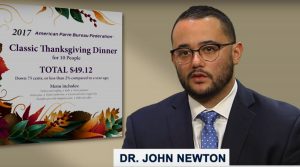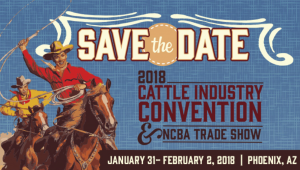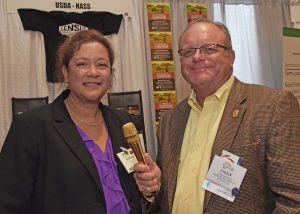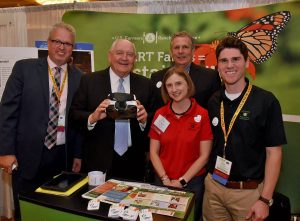 The National Cattlemen’s Beef Association is applauding U.S. House of Representatives passage of H.R. 1, the Tax Cuts and Jobs Act. NCBA President Craig Uden said the approval is a “step in the right direction,” but promised to continue to fight the provision in the bill that would limit the ability of some businesses from deducting interest expenses.
The National Cattlemen’s Beef Association is applauding U.S. House of Representatives passage of H.R. 1, the Tax Cuts and Jobs Act. NCBA President Craig Uden said the approval is a “step in the right direction,” but promised to continue to fight the provision in the bill that would limit the ability of some businesses from deducting interest expenses.- The Leavenworth Livestock Research Center, located near Sleepy Eye, Minn., is a 2,500-head wean-to-finish facility expected to make big advancements in the research sector of the swine industry. The facility offers the opportunity to do research in a realistic commercial production setting. The endeavor is a partnership between Hubbard Feeds and parent company, Alltech.
- The National Pork Board is recognizing U.S. Antibiotic Awareness Week and World Antibiotic Awareness Week with organizations such as the U.S. Centers for Disease Control and Prevention (CDC). The Pork Board has approved a Checkoff investment of more than $6 million for antibiotic-related studies since 2000.
- The U.S. Roundtable for Sustainable Beef (USRSB) has announced the release of USRSB Sustainability Metrics, the latest tool helping those who raise, buy, and sell beef understand ways to balance and improve their environmental impact, social responsibility, and financial bottom line.
- A recent study finds standing Magnetic Resonance Imaging may have an important role in identifying racehorses at risk of condylar fracture. The study imaged 26 cases with catastrophic condylar fracture (CCF) and 88 control cases without CCF. The study was presented at the British Equine Veterinary Association Congress in the United Kingdom and was selected as the winner of the Sam Hignett Award for Clinical Research.
BQA’s New Transportation Training & Certification Program
 The checkoff-funded Beef Quality Assurance (BQA) program has launched a new training and certification program for cattle transportation. The program, known as Beef Quality Assurance Transportation (BQAT), provides cattle producers and haulers with comprehensive training based on their roles in the cattle industry. Online training will be made available beginning immediately, and in-person training opportunities will begin soon.
The checkoff-funded Beef Quality Assurance (BQA) program has launched a new training and certification program for cattle transportation. The program, known as Beef Quality Assurance Transportation (BQAT), provides cattle producers and haulers with comprehensive training based on their roles in the cattle industry. Online training will be made available beginning immediately, and in-person training opportunities will begin soon.
“The BQA Transportation training and certification program has been a long time coming,” said Chase DeCoite, director of Beef Quality Assurance for NCBA, a contractor to the beef checkoff. “By educating cattle haulers and producers on the best practices in cattle transportation, BQA is helping make improvements in cattle care and beef quality. Participating in BQA Transportation will be an indicator that the beef and dairy industries are committed to responsible animal care during transportation and makes both the BQA and dairy FARM animal care programs more complete.”
The BQA program was first funded by the beef checkoff in the early 1990s and developed its first guidance on transportation in 2006. Today, the program offers training and certification programs for all sectors of the industry: cow-calf, stocker and feedyard. This is the first time a nationally recognized certification has been offered for the transportation segment of the industry.
Thanksgiving Dinner Will Cost Less Than Last Year
 This year’s Thanksgiving dinner should cost slightly less than last year, according to the American Farm Bureau Federation‘s 32nd annual price survey of items traditionally used in the Thanksgiving meal. The cost of the dinner is the lowest since 2013, according to Dr. John Newton, AFBF director of market intelligence. The price decrease is primarily driven by the lower cost of the turkey, which is priced at two cents less per pound than last year.
This year’s Thanksgiving dinner should cost slightly less than last year, according to the American Farm Bureau Federation‘s 32nd annual price survey of items traditionally used in the Thanksgiving meal. The cost of the dinner is the lowest since 2013, according to Dr. John Newton, AFBF director of market intelligence. The price decrease is primarily driven by the lower cost of the turkey, which is priced at two cents less per pound than last year.
“This holiday season we have plenty of turkeys available for the consumer,” said Newton. “USDA estimates turkey production is going to be up about one percent from where we saw it last year, and whether you’re consuming a fresh bird for Thanksgiving or a frozen bird, there should be plenty of supplies on hand.”
The shopping list for Farm Bureau’s informal survey includes turkey, bread stuffing, sweet potatoes, rolls with butter, peas, cranberries, a veggie tray, pumpkin pie with whipped cream, and coffee and milk, all in quantities sufficient to serve a family of 10 with plenty for leftovers.
Listen to more with Dr. John Newton here: Dr. John Newton, AFBF
USFRA Continues to Grow and EngAGe
“There were six original organizations…we’re up to over 100 now,” said USFRA CEO Randy Krotz. USFRA elected four new board members at the meeting – James Adams representing the U.S. Poultry & Egg Association, Steve Geick with John Deere, DuPont Pioneer’s Amanda Rinehart, and Blair Van Zetten from the American Egg Board – to join the 18-member Board of Directors.
During the board meeting, USFRA showcased its consumer-facing activities in 2017, including SMART Farm, where USFRA used 360-degree video technology to bring the farm to the consumer at events like the Consumer Electronics Show and the South Beach Wine and Food Festival. “USFRA goes to places that a pork, or cattle, or corn or soybean organization would maybe not go by themselves,” said USFRA chair Brad Greenway, a hog farmer from South Dakota.
Greenway says the SMART farm concept resonates with millennials and USFRA will be carrying it forward into 2018. Other programs and major initiatives for 2018 include the Food Evolution film promotion and enhanced distribution, as well as an exciting new app, engAGe, which aims to activate farmer and rancher voices on digital and social media platforms.
Learn more about USFRA programs in these interviews:
Interview with Randy Krotz, USFRA
Interview with Brad Greenway, USFRA
Trade, Farm Bill & Taxes…Oh My!
 Missouri Farm Bureau President Blake Hurst represented the American Farm Bureau Federation (AFBF) at last week’s NAFB Trade Talk. As you can guess, trade, 2018 farm bill and tax reform we key issues we discussed.
Missouri Farm Bureau President Blake Hurst represented the American Farm Bureau Federation (AFBF) at last week’s NAFB Trade Talk. As you can guess, trade, 2018 farm bill and tax reform we key issues we discussed.
When it comes to NAFTA renegotiations, Hurst said, “U.S. agriculture can see some benefits from this renegotiation. We can see changes to phytosanitary rules. We can see improvements in dairy trade with our Canadian neighbors. So, there is hope.”
Last week we had confirmation that we will not see a vote on the 2018 farm bill this year. No surprise there. State Farm Bureau’s are working on their own resolutions which will be presented at the AFBF Convention in January. Hurst said three key issues he believes will be priorities are county to county differences in ARC payments, dairy and cotton programs.
We wrapped up our chat talking taxes. Listen to my complete interview to hear that and more on infrastructure and the need for wide-spread rural broadband. Interview with Blake Hurst, Missouri Farm Bureau
New Swine Inactivated Mucosal Flu A Virus Vaccine from Aptimmune
 Aptimmune Biologics introduces the industry’s first inactivated mucosal influenza A virus in swine (IAV-S) vaccine administered via nasal spray. Aptimmune’s IAV-S vaccine utilizes the BARRICADE™ proprietary vaccine formulation that gives swine producers and veterinarians a completely different approach to conventional inactivated injectable and live virus vaccines for safely preventing and managing respiratory disease.
Aptimmune Biologics introduces the industry’s first inactivated mucosal influenza A virus in swine (IAV-S) vaccine administered via nasal spray. Aptimmune’s IAV-S vaccine utilizes the BARRICADE™ proprietary vaccine formulation that gives swine producers and veterinarians a completely different approach to conventional inactivated injectable and live virus vaccines for safely preventing and managing respiratory disease.
This inactivated mucosal vaccine is a new class of vaccines that mitigates respiratory disease at the point of entry. BARRICADE™ IAV-S combines three core components essential for effective disease protection: First, contemporary influenza type A antigen relevant for current application. Second, a powerful and safe immune-stimulating adjuvant. Lastly, Aptimmune’s proprietary nanoparticles deliver the vaccine payload to immune cells at the mucosal surface.
 BARRICADE™ IAV-S has shown to target immune cells at the respiratory surface, where the pig is naturally exposed to infection. BARRICADE’S™ revolutionary approach provides veterinarians and producers the opportunity to produce an IAV-S vaccine which may contain up to five contemporary influenza type A strains, such as H1N1, H1N2 and H3N2.
BARRICADE™ IAV-S has shown to target immune cells at the respiratory surface, where the pig is naturally exposed to infection. BARRICADE’S™ revolutionary approach provides veterinarians and producers the opportunity to produce an IAV-S vaccine which may contain up to five contemporary influenza type A strains, such as H1N1, H1N2 and H3N2.
“This inactivated-virus mucosal vaccine with its needleless, intranasal administration is safe to pigs, people, and is PQA-Plus friendly, making it an effective alternative to conventional IAV-S vaccines.”, says Jessica Seate, DVM, professional services veterinarian for Aptimmune Biologics.
BARRICADE™ IAV-S is the second revolutionary, intranasally administered mucosal swine vaccine product introduced by Aptimmune this year, says Aaron Gilbertie, Aptimmune CEO. “Our BARRICADE™ PRRS vaccine continues to perform well on swine farms across the country, under some of the toughest disease conditions and has validated our collaborative innovation model for developing and manufacturing custom mucosal vaccines. And because our PRRS and IAV-S vaccines utilize the same BARRICADE™ technology, they can be combined and administered together to prevent these two important diseases when appropriate.”
Kicking Veal Misconceptions to the Curb
 The 2017 National Association of Farm Broadcasting’s Trade Talk gives voice to agriculture. There we were able to speak with the American Veal Association (AVA) for the first time. Misconceptions flood this industry and I for one, learned many things while speaking with Dr. Marissa Hake, AVA veterinarian who covers herd health in Indiana, Michigan and Ohio.
The 2017 National Association of Farm Broadcasting’s Trade Talk gives voice to agriculture. There we were able to speak with the American Veal Association (AVA) for the first time. Misconceptions flood this industry and I for one, learned many things while speaking with Dr. Marissa Hake, AVA veterinarian who covers herd health in Indiana, Michigan and Ohio.
“One of the biggest misconceptions the industry has been working on the last 10 years is how they are raised. Ten years ago they moved away from crates and into group housing. The veal you buy on the market now is housed in groups of two to 10. They can stand up, lay down, move around and interact naturally. American veal producers have invested in remodeling and new barns to better serve these calves,” Dr. Hake said.
Size is also a misconception. Calves are about five to six months old and weigh about 450 to 500 lbs. They are also never dehorned or castrated and Dr. Hake reminds us that it is illegal to use growth-promoting implants in veal calves.
Listen to my complete interview with Marissa to hear how they are communicating with the consumer and why you should choose veal for that nice meal out. Interview with Dr. Marissa Hake, American Veal Association
Blaze A Trail to #CattleCon18
 How many have already registered to #BlazeATrail in Phoenix, AZ for the 2018 Cattle Industry Convention & NCBA Trade Show? The AgWired team will be heading West to bring you all the #BeefMeet news and views. We spoke with NCBA’s Marvin Kokes last week at NAFB’s Trade Talk to get the scoop on the latest details on #CattleCon18. Man, that’s a lot of hashtags to follow!!!
How many have already registered to #BlazeATrail in Phoenix, AZ for the 2018 Cattle Industry Convention & NCBA Trade Show? The AgWired team will be heading West to bring you all the #BeefMeet news and views. We spoke with NCBA’s Marvin Kokes last week at NAFB’s Trade Talk to get the scoop on the latest details on #CattleCon18. Man, that’s a lot of hashtags to follow!!!
“It’s going to be a great show. Hotel rooms are filling up fast. Registration is going strong. We have Ree Drummond, the Pioneer Women, as our opening general session speaker. We look forward to hearing her share her success and what she is doing to promote beef and agriculture in general,” Kokes said.
The trade show is nearly 8 acres this year with indoor and outdoor exhibit space. Education is a huge component of the event each year and Marvin promises the Cattlemen’s College will be full of current and relevant information cattlemen and women can take home and put into action. And of course, there is entertainment. Listen to my complete chat to learn more about the line up:
Interview with Marvin Kokes, NCBA
View and download photos here: 2017 NAFB Convention Photos
Get Ready for the Census of Agriculture
 It’s that time farmers. The 2017 Census of Agriculture is coming in December. The survey is conducted by the USDA National Agricultural Statistics Service. It has been conducted since 1840 and is a complete count of U.S. farms and ranches and the people who operate them. It takes place every five years.
It’s that time farmers. The 2017 Census of Agriculture is coming in December. The survey is conducted by the USDA National Agricultural Statistics Service. It has been conducted since 1840 and is a complete count of U.S. farms and ranches and the people who operate them. It takes place every five years.
During the NAFB Trade Talk session I visited with Barbara Rater, USDA-NASS, about the new survey. She says there will be new questions that include veteran status, farm decision-making and food marketing practices. There is also a much improved online questionnaire designed to make it easier to fill out. There will also be versions for mobile phone, tablet and desk/laptop computer.
Barbara also talks about the importance of filling out the survey which includes being able to show the country the importance and value of U.S. agriculture. The information will also be useful for influencing decision makers on topics like transportation/marketing locations, farm services, production practices and new technologies and farm policy. I can vouch for the importance of the survey even to those of us in agricultural marketing and ag media. You can watch a message about the Census from our U.S. Secretary of Agriculture, Sonny Perdue, here.
And congratulations to Barbara for becoming a member of the #GoldenMic Club!
Learn more about the new census here: Interview with Barbara Rater, USDA-NASS
Propane Can Do That
 The Propane Education and Research Council (PERC) has launched a new website dedicated to agricultural applications of propane.
The Propane Education and Research Council (PERC) has launched a new website dedicated to agricultural applications of propane.
“It’s a really good site. I think if you’re excited about saving money and having reliable, powerful, clean equipment, it will be a great site for you,” said Cinch Munson with PERC.
The site also offers details about the Farm Incentive Program to help people make the initial investment into propane equipment, offering up to $5,000 towards that type of purchase. Munson said about 10 percent of propane sales go into agriculture applications, from drying grain to heating livestock facilities.
Learn more about propane in agriculture here: Interview with Cinch Munson, PERC


